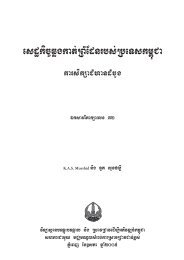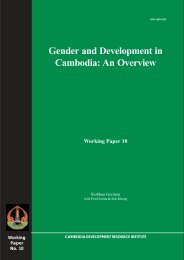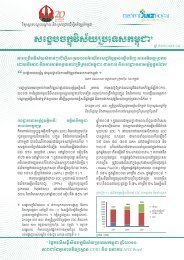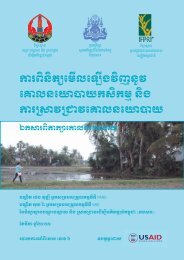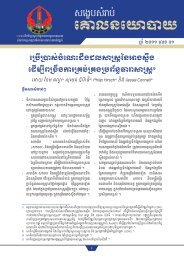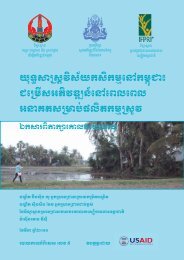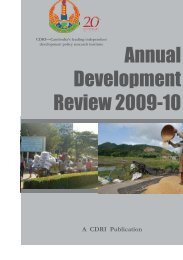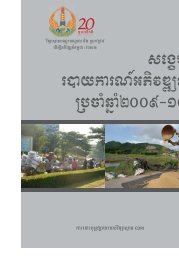62) decentralised governance of irrigation water in cambodia - CDRI
62) decentralised governance of irrigation water in cambodia - CDRI
62) decentralised governance of irrigation water in cambodia - CDRI
Create successful ePaper yourself
Turn your PDF publications into a flip-book with our unique Google optimized e-Paper software.
EXECUTIVE SUMMARY<br />
Cambodia is currently embarked on a significant programme <strong>of</strong> <strong>irrigation</strong> development. The<br />
technical design <strong>of</strong> <strong>irrigation</strong> projects has generally improved, but there rema<strong>in</strong> a number <strong>of</strong><br />
challenges <strong>in</strong> the <strong>governance</strong> <strong>of</strong> <strong>irrigation</strong> that <strong>in</strong>hibit the schemes from work<strong>in</strong>g effectively,<br />
equitably and susta<strong>in</strong>ably. This study <strong>in</strong>vestigates the extent to which the <strong>governance</strong> <strong>of</strong><br />
<strong>irrigation</strong> matches the requirements <strong>of</strong> diverse <strong>irrigation</strong> schemes through detailed ethnographic<br />
study <strong>of</strong> three schemes: Rolous and Stung Ch<strong>in</strong>it <strong>in</strong> Kampong Thom prov<strong>in</strong>ce and Damnak<br />
Ampil (DAP) <strong>in</strong> Pursat prov<strong>in</strong>ce. Specifically, it <strong>in</strong>vestigates (1) the degree <strong>of</strong> match between<br />
the <strong>governance</strong> arrangements and requirements imposed by the physical configuration <strong>of</strong> these<br />
schemes, and (2) ways <strong>in</strong> which stipulated <strong>governance</strong> arrangements have been modified <strong>in</strong><br />
response to local requirements.<br />
The study found discrepancies between actual <strong>governance</strong> practices and the ideal<br />
<strong>governance</strong> pr<strong>in</strong>ciples, as outl<strong>in</strong>ed <strong>in</strong> Participatory Irrigation Management Development (PIMD)<br />
and Integrated Water Resources Management (IWRM), and the spatial and <strong>in</strong>frastructural<br />
context <strong>of</strong> the schemes. Specifically, it was observed that the scale <strong>of</strong> the command areas is<br />
beyond the scope <strong>of</strong> Farmer Water User Community (FWUC) members and activists who do<br />
not have adequate technical knowledge or f<strong>in</strong>ances to repair, develop, and ma<strong>in</strong>ta<strong>in</strong> <strong>irrigation</strong><br />
<strong>in</strong>frastructure across their respective schemes. Second, the actual practice <strong>of</strong> <strong>irrigation</strong><br />
management at the scheme and sub-scheme level diverges significantly from the pr<strong>in</strong>ciples <strong>of</strong><br />
PIMD and IWRM. For example, the actual roles <strong>of</strong> the FWUCs fall short <strong>of</strong> those stipulated <strong>in</strong><br />
their mandate and are not particularly well-executed.<br />
The strongest role <strong>of</strong> the FWUCs across different case-study schemes is that <strong>of</strong> a<br />
mediator between farmers and PDOWRAM, rather than their pr<strong>in</strong>cipal mandate <strong>of</strong> competently<br />
manag<strong>in</strong>g the schemes. The FWUCs also have a role <strong>in</strong> allocat<strong>in</strong>g <strong>water</strong> from primary and<br />
secondary canals, resolv<strong>in</strong>g m<strong>in</strong>or conflicts between farmers with<strong>in</strong> the community, and<br />
collect<strong>in</strong>g Irrigation Service Fees; however, the execution <strong>of</strong> these tasks is <strong>in</strong>consistent and<br />
<strong>of</strong>ten lack<strong>in</strong>g. The f<strong>in</strong>d<strong>in</strong>gs conclude that the current <strong>governance</strong> arrangements deviate from<br />
both the requirements imposed by the physical configuration <strong>of</strong> the schemes and the idealised<br />
theoretical <strong>governance</strong> purported <strong>in</strong> the PIMD policies. The study then suggests that to fix the<br />
problems, changes need to be made to policy and FWUC mandates as well as to the <strong>governance</strong><br />
structure to provide more support to FWUCs and to adapt them to be more closely aligned with<br />
exist<strong>in</strong>g <strong>governance</strong> frameworks.<br />
<strong>CDRI</strong> Work<strong>in</strong>g Paper Series No. <strong>62</strong><br />
ix



